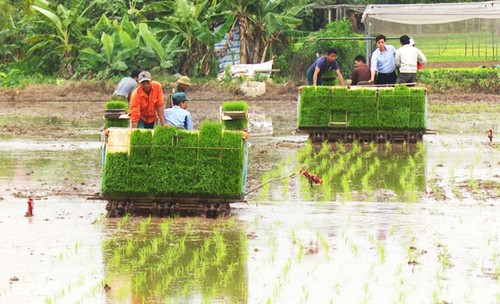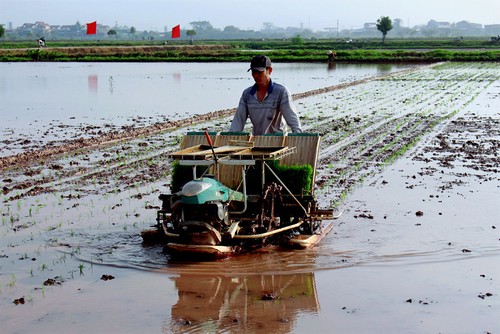
Transplanting rice seedlings by machine in Thuong Tin district has increased productivity. (Photo: hanoimoi.com)
|
Hanoi has 24 districts and towns engaged in farming and 180,000 ha of rice under cultivation. The seed sowing area using machines is only 5,000 ha, 2.7% of the total seed sowing area. Hanoi plans to increase this to 10% next year.
Hanoi continues to promulgate policies that encourage cooperatives, household groups, and individual households to mechanize, and has helped people to buy good, high-capacity transplanting machines.
Nguyen Xuan Dai, Deputy Director of Hanoi’s Agriculture and Rural Development Department, said, “Hanoi is applying advanced technology to agricultural production. About 30% of Hanoi’s agriculture sector uses high-tech. 90% of land tilling and 80% of rice harvesting have been mechanized.”
“Transplanting rice seedlings by machine increases productivity and quality 10 to 15%. Mechanized transplanting saves about 173 USD per hectare in production costs. In one year, Hanoi will save more than 43 million USD by mechanizing farming in addition to the value of the increased productivity,” said Dai.
 Farmers in Dai Thang village, Phu Xuyen district, use machine for rice transplanting. (Photo: hanoimoi.com.vn) Farmers in Dai Thang village, Phu Xuyen district, use machine for rice transplanting. (Photo: hanoimoi.com.vn) |
Phu Xuyen is one of the leading districts in Hanoi for mechanized sowing and transplanting.
Nguyen Trong Vinh, Deputy Chairman of the Phu Xuyen People’s Committee, said, “Phu Xuyen has identified mechanization as a spearhead of agricultural production and promulgated policies to finance up to 3,000 USD per 360 square meters if farmers sow rice seeds and transplant rice seedlings by machine. In 2012, Phu Xuyen only had 70 ha of land using machines to transplant rice. That figure is now 1,000 ha. The area sowed by machine is nearly 14% of the district.”
The mechanization models used in Phu Xuyen have become role models.
Nguyen Khac Duc, President and Director of the Phu Trieu Cooperative in Nam Trieu commune, said, “In 2014 Nam Trieu was the first commune in Phu Xuyen to be recognized as a new-style rural village.”
According to Duc, “cooperative members all agree that it’s easier to take care of rice if it is transplanted by machine. Less fertilizer is needed, while insect pests have been reduced and productivity has increased between 5 and 10%. So we have been encouraging more cooperative members to mechanize. Nam Trieu now has 45 seed sowing machines and mechanized areas are 90% of our rice cultivation land.”
The use of machines to sow and transplant rice has reduced the need for labor and herbicides, which are harmful to the environment, biodiversity, and human health. Seedlings are now less damaged by rats and insects.
Lam Van Quy, a Nam Trieu villager in Phu Xuyen district, said, “Sowing rice seeds and transplanting rice seedlings by machine saves up to 216 USD per hectare in production and labor costs. It narrows the income gap and makes life easier for farmers. 90% of the rice cultivation land in Nam Trieu has been mechanized.”
The Hanoi Department of Agriculture and Rural Development continues to hold intensive training courses in machine operation and repair and will issue policies to help each district and town establish a center for rice seed production and transplantation by machine.